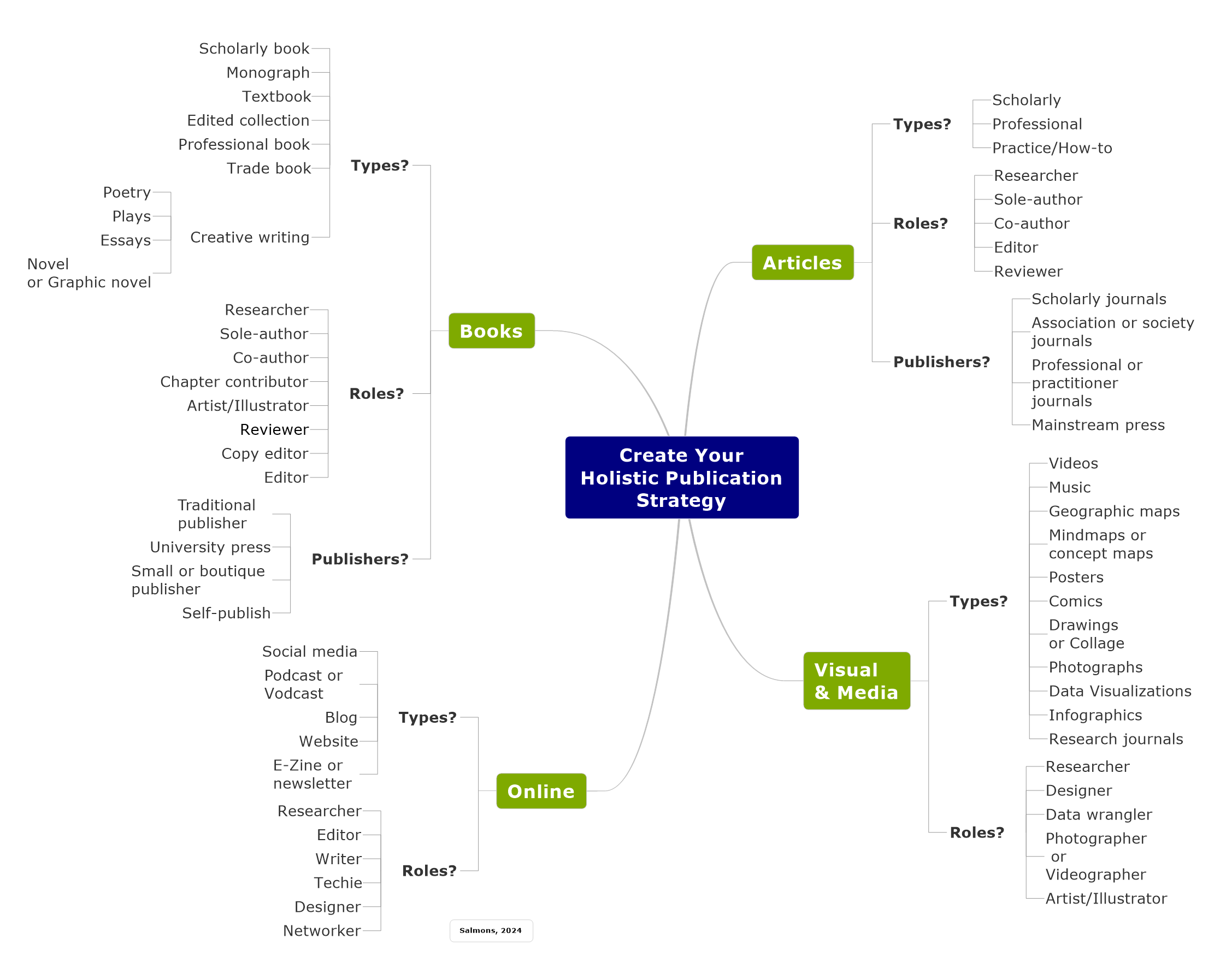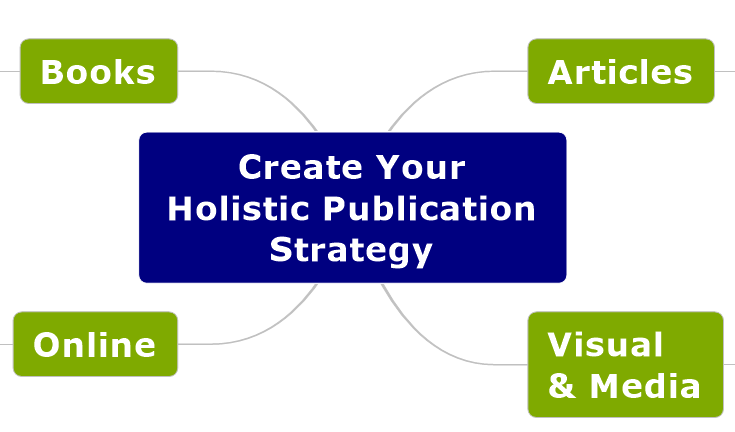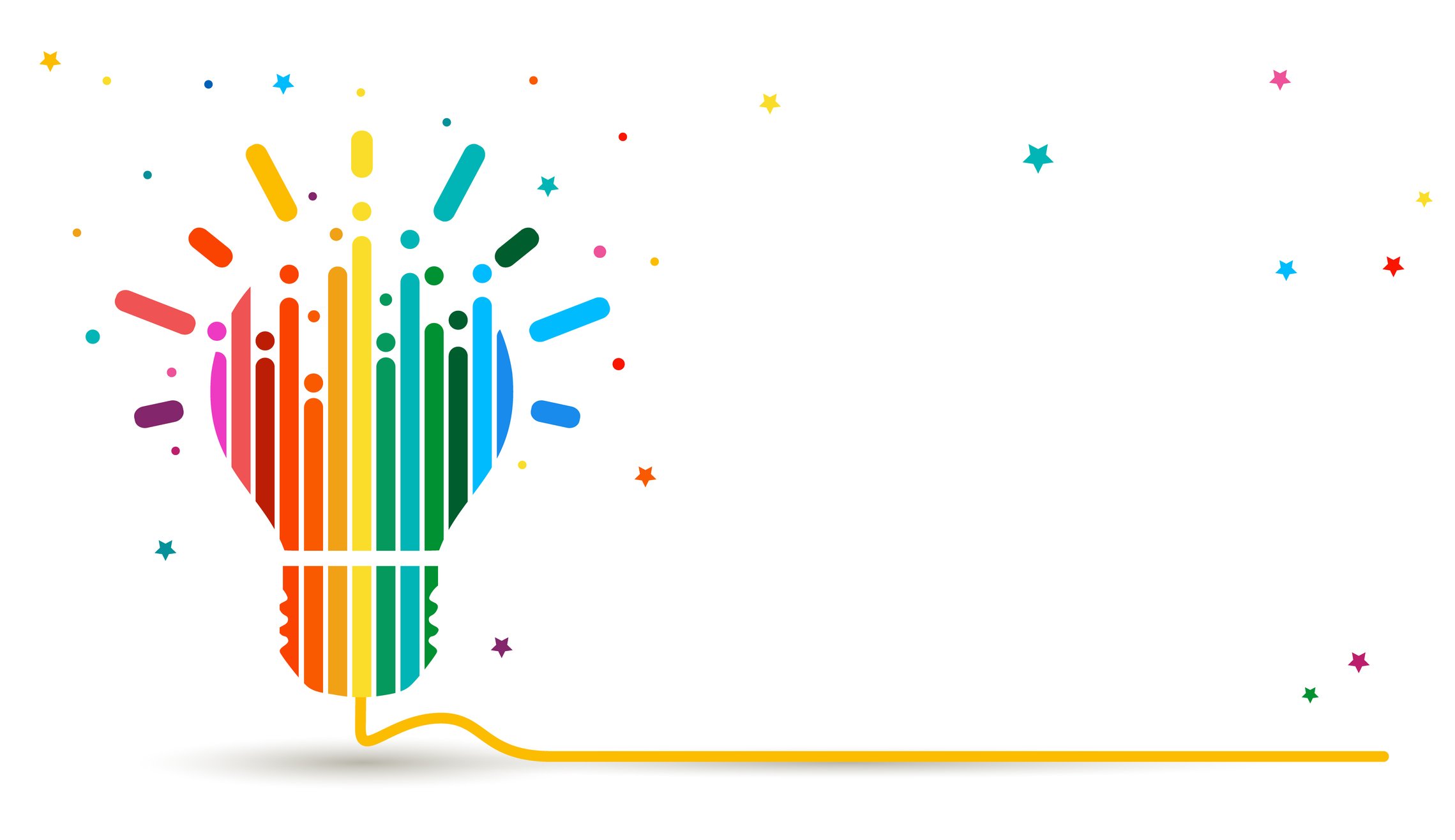What is a "holistic publication strategy"?
By Janet Salmons, PhD Manager, Sage Research Methods Community
Like what you read? Looking for something in particular?
Please complete this short survey to
help us learn how we can better meet your needs.
Think about your own big picture, and how to paint it. There are many options for sharing ideas and disseminating findings. In addition to scholarly writings, you might want to write more practical books or articles that allow professionals, practitioners, or policy-makers to apply your ideas. You might use informal online posts or newsletters to build your name recognition and draw readers to more formal publications.
Maybe you will be more effective at making an impact with a creative output. Some creative options require us to do more than write-- because they involve visuals, media, and/or communications technologies.
As a visual communicator, I like using mind maps to illustrate ideas and relationships. In this map I laid out four broad categories: books, articles, online, or visual/media communications. Within each category, I suggest types of work and roles needed to accomplish it. Look for synergies among the options that best fit your work and intended audience, so that choices are mutually-reinforcing. Let’s call that coherent plan a holistic publication strategy.
A holistic publication strategy is a thoughtful plan of action for aligning career goals with publication options. (Salmons & Kara, 2020)

What will you publish? What roles will you take?
My own strategy involves writing books and blogs.
I generally prefer the substantive writing involved with books. I also like the immediacy of blogging, offered here on the Sage Research Methods Community and as a guest on other sites For both books and blogs I create a lot of visuals, including drawings, diagrams, photography, and media. In terms of roles, I am a researcher, an author and co-author, a chapter contributor, and an artist. I also take on editing and reviewing tasks when I work with other scholars.
What is your strategy?
Reflect on your career goals and publication needs. Think about the roles where you feel proficient and those where new skills are needed. For each project, identify the roles you will take, those collaborators or co-authors might take, and those you need to hire someone else to do.
Download the Publication Strategy map and annotate it. Add notes, prioritize items, color code items, or add dates to make it your own. Print it out and post it on the wall near your writing desk. When you have a publication strategy, instead of feeling that you are being pulled in too many directions, you will find a sense of coherence in your writing activities.
Learn more about publication strategies in this book, co-authored with Dr. Helen Kara: Publishing from your Doctoral ResearchCreate and Use a Publication Strategy.
More Sage Research Methods Community Posts about Writing and Getting Published
Dissemination of research findings is a key part of every researcher’s journey, and this insightful webinar will empower you to make informed decisions to maximize the impact of your scholarly work.
Find examples and guidance about collecting data on blogs or vlogs.
by Maria Lahman, Ph.D. and Tyler Kincaid Ph.D., panelists for the How to Do Research and Get Published webinar, “How to write a paper: Qualitative methodology” share their insights.
Conduct a reference search and format your reference section was offered as part of the How to Do Research and Get Published webinar series. Watch the recording and find lots of useful resources in this post.
Find a collection of resources about writing and publishing articles and more!
Learn about research design, doctoral writing, and academic publishing with these posts and recordings from Dr. Linda Bloomberg and Dr. Merle Werbeloff.
Think about your own big picture, and how to paint it. There are many options for sharing ideas and disseminating findings. What will work for you, based on the nature of your research, your findings, and your career goals?
This list of books and articles include a range of discussions about academic and research careers.
Want anyone, whether or not they are associated with an institution that allows them access to an academic library? Learn about open access and how to publish your OA article.
Jessica Lester and Trena Paulus co-edited a December 2023 special issue for the Sage journal, Qualitative Inquiry, “Qualitative inquiry in the 20/20s: Exploring methodological consequences of digital research workflows.” Read the articles and watch a roundtable with contributors. This is the second of two discussions of the special issue.
Jessica Lester and Trena Paulus co-edited a December 2023 special issue for the Sage journal, Qualitative Inquiry, “Qualitative inquiry in the 20/20s: Exploring methodological consequences of digital research workflows.” Read the articles and watch a roundtable with contributors. This is the first of two discussions of the special issue.
Academic writing is not always writing! Pictures and media enliven our writing, and can be important for showing concepts and contexts.
How and why should you argue in academic writing? Learn more from Dr. Alastair Bonnett, author of How to Argue.
Thinking about research careers and calling: finding the right fit.
What do journal editors want? Read an open-access collection of editorials that offer practical suggestions about how to organize and write an article that will pass the review process and get published.
Safary Wa-Mbaleka, Arceli Rosario, and Anna Cohen Miller discussed opportunities and challenges for global researchers and academic writers in this roundtable discussion.
Jo VanEvery believes that a writing practice based on the desire to write and enjoyment of the intellectual challenge will produce the outputs you are under pressure to produce. Learn how in this post!
AI can do a lot of things but it cannot do originality. Learn more from Dr. Alastair Bonnett, author of How to Be Original.
In this presentation, Dr. Linda Bloomberg explains how to think through key questions associated with presentation of qualitative findings, and walks through an example that demonstrates ways to align research designs with presentation strategies.
Dr. Linda Bloomberg offers detailed suggestions for getting organized and starting a dissertation or thesis.
Connect or reconnect to the joy of writing with these tips from Dr. Katherine Firth.
How can critical thinking skills help you write more precisely? In this post Dr. Alex Baratta offers some practical tips.
Between 2015 and 2022 Paul Atkinson produced four books about ethnography. How and why did that happen, and what did he want to achieve? Learn about this quartet of books.
Applying an equity focused lens specifically to reporting and dissemination necessitates a careful and deliberate approach. Learn more in this post!
Learn about disseminating research with an equity lens in this guest post from the CTE Research Network Equity Working Group.
This post from Dr. Alex Baratta explains different approaches to academic writing and offers practical guidance.
Writing is often a solitary activity. However, reflection with others is a key part of understanding how to develop and define ideas from text. Learn more in this post.
The report from PEN America, Speech in the Machine: Generative AI’s Implications for Free Expression, connects dots that are important to academic writers: intellectual freedom, and protection of intellectual property. Summer Lopez, PEN’s Chief Program Officer for Free Expression agreed to talk about these issues and controversies.
This must-read article in The Scholarly Kitchen caught my attention: “Who Is Going to Make Money from Artificial Intelligence in Scholarly Communications?” See this thought-provoking interview with the author, Joseph Esposito.




























Look candidly at your unfinished project. Is it a stepping stone, and completion will be allow you to move ahead? Or is it an obstacle that prevents you from moving forward? Find ideas to help you determine whether to revive that piece of writing or let it go.